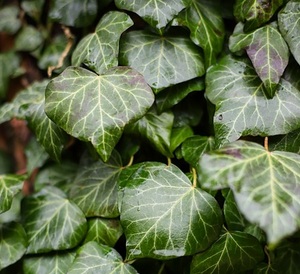Summary: Make your own ivy tea
against coughs etc.:
Find 1 ivy leaf - wash - cut into small
pieces in 1 cup - pour on hot water - strain - take -
maximum 14 days per month
by Michael Palomino - July 25, 2024
Make your own ivy tea: find 1 ivy leaf and wash it well,
chop it up into a cup, leave it in hot water for 10
minutes, strain the tea (i.e. strain it into a second
cup), take the tea WITHOUT the chopped ivy leaves.
I would take it in case of illness
-- in isolation
-- at least 1 hour away from meals and
-- 30 minutes away from other drinks.
This tea of 1 ivy leaf diluted in a full cup is not very
concentrated but harmless. Eating ivy leaves and ivy
flowers or ivy berries as a salad is poisonous. Drinking
the ivy tea WITH the ivy pieces is poisonous. So be sure
to sieve it.
Here are some websites in German:
https://duckduckgo.com/?t=h_&q=efeutee+against+cough&ia=web
Search for ivy in English:
https://duckduckgo.com/?q=ivy+tea+against+cough+&t=h_&ia=web
Now the Mossad is afraid of ivy, but ivy is also in many
cough syrups.
Anyone who eats ivy raw or drinks the snippets will make
themselves ill: see ivy poisonous:
https://duckduckgo.com/?t=h_&q=ivy+poisonous&ia=web
And here's another warning: there is one web site saying
that you should pick the leaves with gloves on [and then
throw the gloves away or wash them?]
Yes, they are scary, the Mossad brothers. So just wash the
leaf well, then your hands will be washed as well.
Take ivy tea for a maximum of 14 days per month, because
that is enough - and you can also change the remedy from
time to time. However, animal experiments have shown that
taking ivy tea for months does not provoke diseases.
Here are some other remedies against bronchitis:
http://www.med-etc.com/med/merk/merkblatt-bronchitis.htm
La lala lalaaa: Blood group nutrition -- Color therapy --
Anise -- Wild garlic -- Deer tongue fern wine -- Pine salve
rub -- Black cumin -- Masterwort -- Horsetail tea /
horsetail tea -- Horseradish syrup -- Black radish syrup --
Radish essence -- Bee honey -- Red snail syrup -- Coltsfoot
tea -- Primrose tea -- Ribwort tea -- Marshmallow tea --
Ivy: ivy leaf extract, ivy tea -- honey + ginger + bee resin
(propolis) -- baking soda -- silver water -- nasturtium --
nasturtium + horseradish -- horseradish -- peppermint oil +
peppermint tea -- thyme -- fig juice
News
about ivy in natural medicine
Oct 28, 2021: Ivy - varieties,
medicinal plant and application
Plague, gout, jaundice and bad
hearing
Ivy – varieties,
medicinal plant and application
(orig. German: Efeu – Sorten, Heilpflanze und
Anwendung)
https://www.heilpraxisnet.de/heilpflanzen/efeu-sorten-heilpflanze-anwendung/
Written by Dr.
phil. Utz Anhalt
Translation
with Deepl:
Summary:
Ivy="climbing grass”
Ivy was the medicinal plant of the year in Germany in
2010. The word “ivy” probably comes from the Saxon
“ebah”=climbing, and the Old High German “ep-hou”
means “climbing grass”. Common names for ivy in
Germany are periwinkle, wall ivy, carpet, wall wig,
wintergreen and death tendril.
Ivy climbs up trees, but if there is too much of it,
the tree can die. Ivy climbs up fences and buildings
and always stays green. Most ivy species also grow in
the shade and in wet or dry conditions. Ivy propagates
by cuttings. Quote:
“Ivy is easy to propagate in the garden. All you have
to do is pull cuttings into the soil and water them.”
[Gardener Hungary: Cut off the tip (about 20cm) of an
intact ivy and stick it into the ground, so a new ivy
plant grows in a new place, water it well].
The evergreen ivy of Greek gods and goddesses
Ivy is an ancient medicinal plant of the Greek gods
Demeter (fertility), Pan (forest + shepherds),
Dionysus (wine + sensual pleasure) and Apollo
(poetry). You can still recognize it today in Greek
reliefs: with ivy wreaths. Ivy is documented in
Germany from 1561 by the nature researcher Conrad
Gessner. In England, gardeners took special pleasure
in ivy from 1700 onwards and cultivated further
varieties. Healing effects were cultivated “against plague,
gout, jaundice and bad hearing”.
The evergreen ivy is a
primal symbol of loyalty and immortality
Symbolically and poetically, ivy is attributed to fidelity
and immortality. Ivy grows on graves in legends (Tristan and
Isolde). When “Christianity” [the “Christian” terror of the
gay Vatican] still forbade surgery, an ivy leaf with its
“heart shape” stood as a symbol of “infinite love and
fidelity”. The adhesive roots are supposed to symbolize
fidelity. So-called “Christians” [from the gay Vatican] then
claimed that ivy stood for eternal life after death and had
it growing on their luxury graves [industrial families, cr.
Freemason families], especially from the 19th century,
combined with the evergreen rosemary and boxwood.
Oct 28, 2021: The healing effects of ivy
leaves
(orig. German: Efeu - Sorten, Heilpflanze und
Anwendung)
https://www.heilpraxisnet.de/heilpflanzen/efeu-sorten-heilpflanze-anwendung/
Translation with Deepl:
Ivy leaves = antibiotic in the body and on the skin
The active ingredients in ivy leaves are
-- Hederacoside B and hederacoside C
-- alpha-hederin
-- caffeic acid derivatives
-- flavonoids
-- essential oil
-- glycosides
-- chlorogenic acid
Ivy berries are toxic: The active ingredients in ivy
berries are
-- Triterpene saponins are highly concentrated in the ivy
berries, are toxic to humans from 3 to 4 berries with
headaches, palpitations, cramps, high doses provoke shock
+ respiratory arrest
Ivy tea
-- Ivy leaves have an antibiotic effect
against bacteria, viruses (flu viruses), fungi and
parasites (including worms), expectorant, against
colds, respiratory diseases, coughs (extract
from ivy leaves)
-- Ivy leaves are effective against skin diseases
(skin fungi)
-- Ivy leaves in combination with massage are effective
against cellulite and stimulate blood
circulation in the capillaries [heals eventually
Varicose veins?]
-- Ivy leaves also have an anaesthetic effect.
Quote:
“In low doses, the poisonous effects of the leaves prove
effective against bronchial diseases, spasmodic and
irritable coughs. The poisonous triterpene
saponins cause the bronchial mucosa to produce thin mucus.
This makes it easier to cough up the mucus. An extract
from ivy leaves also ensures that the mucus is better
removed. Alpha-hederin relaxes the bronchial muscles and
thus loosens cramped airways.”
Healing effect of ivy leaves is also recognized by the
Rockefeller mafia
Quote:
“The Herbal Medicinal Product Committee [HMPC of the EMA
in Brussels - Link]
has recognized ivy leaves as a medicine for expectoration,
and the Commission E of the German Federal Institute for
Drugs and Medical Devices considers ivy leaves to be
effective for “catarrhs of the airways and for the
symptomatic treatment of chronic inflammatory bronchial
diseases.””
Ivy can be combined well with other expectorants such as
thyme, primrose root and eucalyptus. Ivy is an element in
cough drops, cough syrups and cough tablets. Ivy tea
should only be made with a small amount of ivy leaves,
otherwise the poisonous effect becomes dominant.
Ivy extract rubbed into the skin is safe for nerve inflammation,
rheumatic pain, lumbago and arthritis.
Cellulite: “Ivy also helps against
cellulite, as on the one hand it anesthetizes [the skin]
and can therefore be massaged more vigorously, and on the
other hand the vasoconstriction caused by ivy removes
stored water from the tissue” [so eventually
also against edema].
Making ivy compresses [for desintoxication]
-- Simmer the ivy tea for approx. 10 to 12 minutes (0.75
liters of water with 1 “handful of ivy leaves” [well
washed and cut into little pieces])
-- Immerse cloths and place around the body once a week.
Make an ivy tea
-- 1/2 teaspoon [of cut] ivy leaves, pour boiling water
[0.75 liters?] over them, leave to infuse for approx. 10
minutes, strain, take 2 cups daily
-- against colds, coughs and inflammation of the
mucous membranes in the nose, mouth, throat and
respiratory tract
-- agianst the bitter taste of ivy, you can sweeten it
with honey, for example.
Ivy tincture
For an ivy tincture, wash ivy leaves, cut them and pour
the parts into a container with an airtight lid.
Furthermore, you fill in high-proof clear schnapps such as
grappa, vodka or gin and let everything steep for a month.
After that, pour the tincture into dark bottles. If you
have a juice blender, you can also mix the ivy with the
alcohol, the tincture will then take on a dark green color
like absinthe.
Ivy ointment
-- Melt beeswax in a water bath, mix with a carrier oil
(olive oil, rapeseed oil, sunflower oil), add chopped ivy
leaves and stir with a blender, [let it cool and fill it
in glasses etc. - spread it]
-- Ivy ointment is effective against wrinkles, for
blood circulation, for wound healing, against
inflammation
Contraindications
-- Do not ingest or rub if there is an allergy to ivy
-- Avoid ivy fruits with a high saponin content if there
is an allergy to ivy
-- Never take more than 3 grams of dried ivy leaves per
day
Author and source information
This text complies with the requirements of medical
literature, medical guidelines and current studies and has
been reviewed by medical professionals.
Authors:
Dr. phil. Utz Anhalt, Barbara Schindewolf-Lensch
Sources:
-- Stauss-Grabo, Manuela; Atiye, Saynab: "Ivy - a
traditional medicinal plant in modern phytotherapy" (orig.
German: “Efeu-eine traditionelle Heilpflanze in der
modernen Phytotherapie”); In: Zeitschrift für
Phytotherapie, 30(30), 2009, Thieme Connect
-- Phytocon Development and authorization of herbal
medicinal products (Phytocon Entwicklung und Zulassung
pflanzlicher Arzneimittel):
www.phytocon.ch (Retrieved: 13.04.2018), phytocon.ch
-- Gottfried Mayer, Johannes: "Ivy – Hedera helix L. –
Cultural-historical portrait of a medicinal plant" (orig.
German: “Efeu - Hedera helix L. - Kulturhistorisches
Porträt einer Arzneipflanze [1]”, in: Zeitschrift für
Phytotherapie, 31(5), 2010, Thieme Connect
-- van Wyk, Ben-Erik; Wink, Coralie; Wink, Michael:
Handbuch der Arzneipflanzen: An illustrated guide,
Wissenschaftliche Verlagsgesellschaft, Wissenschaftliche
Verlagsgesellschaft, 2003
-- Volger, Eberhard: Brinkhaus, Benno: Course book on
naturopathy: for continuing medical education (orig.
German: Kursbuch Naturheilverfahren:
für die ärztliche Weiterbildung), Urban &
Fischer Verlag/Elsevier GmbH, 2013
-- Winckler, Nathali: Thyme, nettle and carrots, this
could be our revolution: A reader on Western plants from
the perspective of Traditional Chinese Medicine, Books on
Demand, 2017 (orig. German: Thymian, Brennnessel und
Karotten, das könnte unsere Revolution sein: Ein Lesebuch
über westliche Pflanzen aus Sicht der Traditionellen
Chinesischen Medizin)
-- Fetzner, Angela: My favorite native medicinal plants
(orig. German: Meine liebsten heimischen Heilpflanzen),
Books on Demand, 2019
-- Blech, Michael: Studies on the wreath among the Greeks
(orig. German: Studien zum Kranz bei den Griechen), Walter
de Gruyter, 2011
-- Kremp, Dieter: When the mists roll in November. Father
Death, Death Moon and Soul Moon (orig. German: Wenn im
November die Nebel wallen. Gevatter Tod, Totenmond und
Seelenmond), Engelsdorfer Verlag, 2011
April 12, 2013: Ivy - healing effect
against coughs
(orig. German: Efeu - Wirkung)
https://www.gesundheit.de/lexika/heilpflanzen-lexikon/efeu-wirkung
(undated - first registered in the internet archive on
April 12, 2013)
Internet archives:
https://web.archive.org/web/20240302010755/https://www.gesundheit.de/lexika/heilpflanzen-lexikon/efeu-wirkung-id214765/
The saponins contained in ivy leaves in particular have an
expectorant effect, i.e. they make it easier to cough up
mucus from the respiratory tract. This can be explained by
indirect irritation of a specific nerve (vagus nerve) in
the stomach. Saponins also irritate the skin and mucous
membranes and stimulate secretion.
The active α-hederin, the flavonoids and the chlorogenic
acid esters also have an antispasmodic effect.
Ivy: side effects
Summary: Anyone with an ivy allergy or an allergy to other
araliaceae should not take ivy.
Ivy - Dosage
https://www.gesundheit.de/lexika/heilpflanzen-lexikon/efeu-dosierung
Dry extracts obtained from ivy leaves are available in
monopreparations in the form of tablets, effervescent
tablets, coated tablets, juices, drops, suppositories and
other forms. Ivy is also contained in some combination
preparations in drop or juice form, for example together
with thyme extract.
Average daily dose
Unless otherwise prescribed, the average daily dose is 0.3
g of ivy leaves [cut into little pieces].
Ivy: Preparation of ivy tea
To prepare a tea from ivy leaves, pour boiling water over
0.5 g of the drug (1 teaspoon corresponds to about 0.8 g)
and strain through a tea strainer after 10 minutes.
Dry extracts obtained from ivy leaves are available in
monopreparations in the form of tablets, effervescent
tablets, dragees, juices, drops, suppositories and other
forms of preparation. In addition, ivy is contained in some
combination preparations in drop or juice form, for example
together with thyme extract.
For inflamed mucous membranes of the
respiratory tract, coughs and colds, 1 cup can be drunk
1-2 times a day. Honey can be added to sweeten the tea to
mask the bitter taste.
Ivy leaves should be stored in a dry place and protected
from light.
Warning: Ivy fruits (ivy berries) are poisonous in high
concentrations.
Oct 20, 2018: Healthy properties: ivy as a
medicinal plant: against arthritis, gout, rheumatism,
detoxification, psoriasis, eczema, acne, bronchitis,
cough, reduces cancer
(orig. German: Gesunde Eigenschaften: Efeu als
Heilpflanze)
https://praxistipps.focus.de/efeu-als-heilpflanze-dafuer-koennen-sie-ihn-anwenden_105610
Ivy is a plant of the Hadera class that grows mainly in
parts of Europe, Asia and North Africa. It is easy to grow
and only requires suitable areas and direct sunlight (green
ivy can grow in damp shade, colored ivy needs at least 3
hours of sunlight per day [web01]). Although ivy is mostly
only used as decoration in or around the house, the leaves
have long been used as a medicinal plant in many parts of
the world.
--
Anti-inflammatory effects: A study shows that tea
or topical application of English ivy leaves helps with
inflammation such as
arthritis, gout or rheumatism.
--
Detoxification of the body: Studies have shown
that ivy
helps the liver and gallbladder by removing
toxins from the body more easily and
reinstalling
the blood.
--
Antibacterial medication: Ivy can help reduce
irritation caused by
psoriasis, eczema, acne and
other skin conditions. The active ingredient can
be taken as a gel or applied directly to the skin [put and
rub a little bit the tea or the cream on the skin].
--
Helps with inflamed airways: ivy leaves
relieve
the bronchial system and reduce inflammation.
--
[Cancer]: Preventing the development of cancer cells:
Studies have shown that English ivy leaf [tea] intake
significantly contributes to antioxidant activity and
reduces
the potential for cancer cells to spread and
develop.
[Warning]: What you should know before use
Ivy products are safe to take if the recommended dose
is not exceeded.
-- Taking too much can be dangerous as the plant
contains various saponins and, among other chemicals,
polyin. Poisoning symptoms such as nausea and vomiting
can occur.
-- People with sensitive skin, pregnant women and
children should be careful before using the medicinal
plant.
-- Ivy can cause skin irritation and other allergic
reactions under certain circumstances [allergy against
ivy].
-- It is therefore advisable to consult a naturopath
or pharmacist in advance to prepare a safe intake
program.
[You can test yourself by drinking half a cup of ivy
tea and rubbing some ivy tea on your skin - and if
there are no negative reactions within a day, you can
start treatment with ivy tea or another ivy
preparation].
Taking ivy
There are the following ways of taking it:
-- Direct ingestion: use three leaves a day of
English ivy [cut and prepared as an ivy tea] for a
week.
-- Tincture: You can use medicines with the
healing properties of ivy for various injuries.
-- Tea: English ivy leaves can be prepared for
tea to cleanse the digestive system.
May 7, 2021: With ivy extract against coughs
and respiratory diseases
(orig. German: Mit Efeuextrakt gegen Husten und
Atemwegserkrankungen)
https://www.gesundheitswissen.de/heilpflanzen/heilpflanzen-starkes-immunsystem/mit-efeuextrakt-gegen-husten-und-atemwegserkrankungen/
The medicinal plant ivy is known as an extract to treat
coughs
and other
respiratory diseases.
The uses of ivy at a glance
The active ingredients of ivy are mainly found in the
leaves. Ivy leaves are called saponins (from the Latin
“sapo” = soap) because they foam when dissolved in water.
When is ivy used?
-- Acute and chronic respiratory diseases, e.g.
cold
cough, bronchitis, whooping cough, bronchial asthma,
bronchial diseases in general
--
Hyperthyroidism due to iodine deficiency
The new discovery that some hederasaponins have
cell-damaging
effects against tumor cells is very promising.
It has also been shown that certain substances in this group
can
protect against mutations caused, for
example, by the well-known carcinogen
benzpyrene.
Another group of substances from ivy, the polyacetylenes
(falcarinone, falcarinol), is also effective against
fungal
infestation, but also has
antibacterial,
pain-relieving and calming effects.
The most important ingredients of ivy
-- hederasaponins
-- polyacetylenes
-- Sterols (stigmasterol, sitosterol, cholesterol,
campesterol)
-- Caffeic acid, chlorogenic acid
-- essential oils and others
[Against cough]: According to studies by
the University of Bonn, the saponin alpha-hederin in
particular stimulates the formation of substances that
liquefy thick mucus. This makes it easier to cough up and
breathe through, reduces the urge to cough and allows the
bronchial tubes to relax. When administered as a
supportive treatment for asthma, ivy can
alleviate breathlessness and coughing fits. The saponins
also inhibit the growth of viruses and bacteria.
[Warnings]: Caution: These are the side effects of the
medicinal plant ivy
-- not eat ivy as a raw food
-- only little intake of ivy tea during pregnancy and
lactation
-- gloves
Despite all its positive properties, it should be borne in
mind that the plant is poisonous. Children in particular
can suffer from diarrhea and cramps if they eat the
fruits, berries or leaves, even in very small quantities.
Gloves are recommended when pruning the plant in the
garden because the sap from ivy leaves, for example, can
cause severe skin rashes. Only herbal preparations from
the pharmacy should be used. To be on the safe side, you
should refrain from taking ivy during pregnancy and while
breastfeeding.
Ready-made preparations for safe use

Ivy is often contained in cough syrupPhotoSG - Adobe
Stock
To be on the safe side when taking ivy, you should only
buy and take preparations from the pharmacy. Ivy is
contained in many medicines as an extract for coughs and
cold symptoms, for example in cough syrups, lozenges and
capsules or for taking as drops [ivy drops].
Extracting the active ingredients from ivy
To extract the active ingredients, the dried ivy leaves
are first rinsed with a mixture of water and alcohol to
dissolve out the ingredients. The alcohol is then removed
and the remaining concentrate is dried. This dry extract
is then processed into high-quality preparations in such a
way that the proportion of ingredients always remains the
same.
Ivy as a houseplant
Ivy can also be used as a houseplant in a pot and is not
very demanding to care for. Spray the plant with low-lime
water from time to time. It should also be watered
regularly, but ivy needs significantly less water in
winter as it is in a kind of winter break at this time and
reduces its growth.

Ivy grows quickly and prolifically and can cover
entire house walls bennian_1 - Adobe Stock
Planting and caring for ivy yourself
If you want to plant and care for ivy outside in the
garden, it's no problem. Ivy prefers to grow in the shade,
but also likes sunny spots.
-- green ivy grows in the damp shade or in the sun [web01]
-- colored ivy must have at least 3 hours of sun every day
[web01]
The only important thing is that the soil should ideally
have plenty of moisture. Please note that ivy can climb
really quickly and is then almost impossible to control.
Although the plant is hardy, moist soil is a must for ivy,
especially in winter, as otherwise it will dry out in
frost. This causes a shoot to dry out and turn brown.
Is ivy poisonous?
Yes, all parts of the evergreen climbing plant are
poisonous and should therefore only be handled with
gloves. Children in particular should not come into
contact with ivy, as even a small amount of the fruits,
flowers and leaves can lead to cramps and diarrhea. You
should therefore only take ivy in the form of medicines
from the pharmacy.
What is ivy good for as a medicinal plant?
The climbing plant is often used in medicines to cure respiratory
diseases such as asthma, cold coughs or bronchitis.
It also helps with hyperthyroidism due to iodine
deficiency.
What varieties of ivy are there?
There are six different varieties of ivy:
1. Hedera helix buttercup: Recognizable by its almost
butter-yellow foliage
2. Hedera helix Eva: Recognizable by its pale green foliage
with thick, white edges
3. Hedera helix Anne Marie: Recognizable by its blue-green
foliage with a white edge
4. Hedera helix Maple Leaf: Recognizable by its green
foliage with a maple-shaped and 3-lobed leaf form
5. Hedera helix atropurpurea: Recognizable by its dark
red-green foliage with green veins
6. Hedera helix goldheart: Recognizable by its creamy white
leaves and thick, green margins.

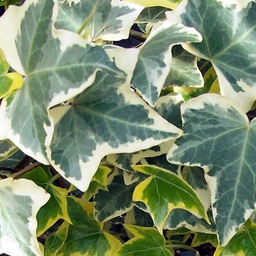


Hedera helix Buttercup [3] - Hedera helix Eva [4] -
Hedera helix Anne-Marie [5] - Hedera helix Maple Leaf
[6]
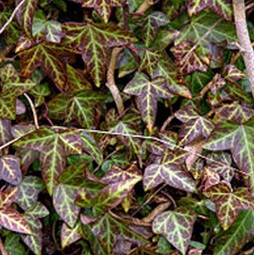
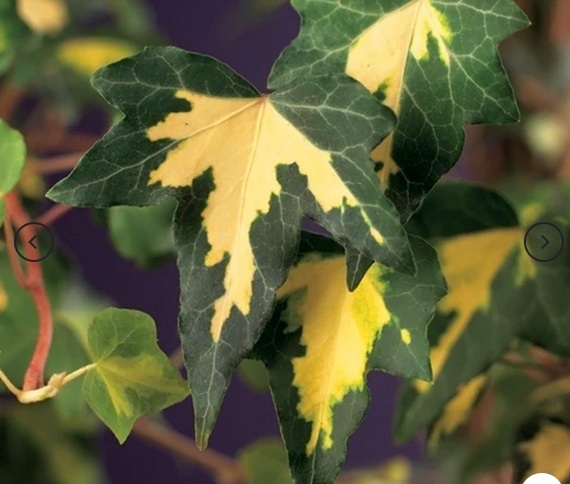

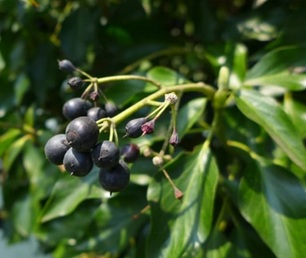
Hedera helix atropurpurea [7] - Hedera helix goldheart
[8] - Ivy flowers [9] - Ivy fruits / ivy berries [10]
Ivy only flowers when the plant is older. If this is the
case, the flowering time is in the fall. This is when
spherical umbels of yellow flowers form, which then grow
into seed heads bearing black fruits [berries].
The leaves of ivy young and old
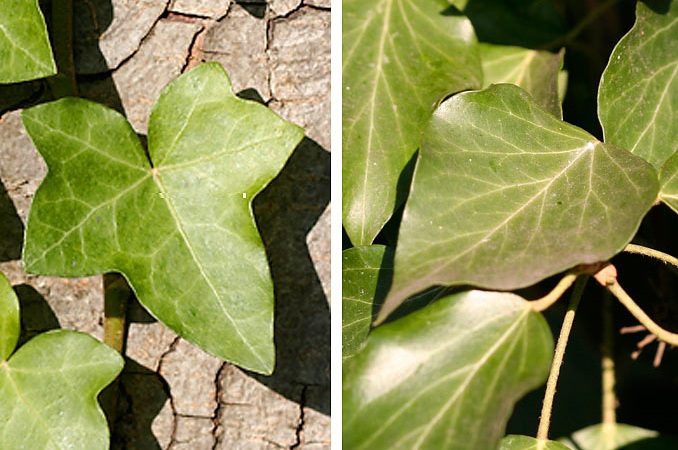
Ivy leaves, young jagged like maple and old like a
sweetheart [11]
-- ivy has to grow 8 to 10 years until it blooms [web02],
first it is ground cover, and from about 10 years it climbs
easily up to over 10m high, climbs on walls, fences, walls,
the climbing adhesive feet can cause damage on wood, blind
boxes and under bricks [web03]
-- ivy blossoms bloom in late summer (August) and are very
popular with insects when the meadows are mowed [web03]
-- there are bees, wasps, beetles, butterflies like admiral,
peacock eye, little fox, goldfinch butterfly [web02]
butterflies, hoverflies, wild bees, wasps [web03]
-- the ivy bee (Colletes hederae) needs the ivy pollen as
food and for its brood [web03]
-- in winter adult butterflies hibernate in the ivy thicket,
e.g. lemon butterfly, C-butterfly, Admira. etc. [web03]
-- the ivy berries ripen in winter and are ripe in March,
then they are the food for returning migratory birds like
blackcaps, starlings, blackbirds, thrushes [web03]
-- adult ivy is nesting place for birds like blackcap and
blackbird [web03]
Jan 1, 2024: Ivy
tea and ivy compresses with ivy tea:
Respiratory diseases (cough, bronchitis,
rickets, etc.), skin problems, vascular injuries (veins,
capillars, ev. varicose veins), ulcers, swellings, skin
infections, inflammations, orange peel skin, tissue
decay
Ivy
(orig. German: Efeu)
https://www.naturheilkraeuter.org/efeu/
Translation with Deepl:
The recommended average daily dose for an adult is 0.3 g
of the [cut] leaves [prepared as an ivy tea].
Brigitte January 24, 2014
Last update: January 6, 2019
Ivy, or “Hedera helix”, is a plant that can be found
everywhere. Only a few people know that it is a
medicinal plant. The plant's active ingredients can be
used for various illnesses, for example in the form of
tea with an expectorant effect, tinctures and compresses
that are used for skin problems.
It can be used for respiratory diseases as
it has an expectorant effect. But it is also said to have
a healing effect on all kinds of skin diseases.
Even in ancient times, ivy tendrils were seen as a symbol
of life and used in many rituals. The leaves were
boiled in wine and the decoction used as a liniment.
At celebrations, young girls were put a wreath of ivy on
their head to show that they were looking for a husband.
General information
Ivy plant as a medicinal herb
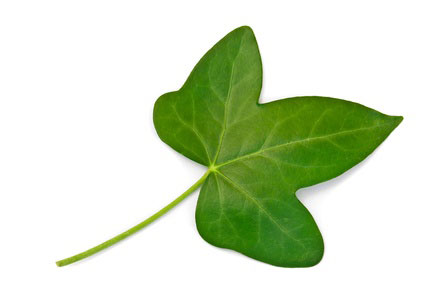
Ivy and its healing properties
Genus: Araliaceae (Araliaceae)
Other names
Tree death, poet's herb, wall green, periwinkle, green
loop, climbing green, shade green, wall burdock.
Characteristics
Hedera helix is a climbing plant that can be found
throughout Europe. It grows particularly well in moist,
calcareous soil. If care is not taken, it can spread
rapidly and kill other plants. It has small aerial roots
that cling to everything, so it can also climb up walls.
In doing so, it destroys the masonry and is difficult to
remove. It also climbs up the trunk of some trees,
depriving the tree of air and nutrients. It can cause less
damage when used as ground cover, for example on a grave.
As a ground cover, it prevents snails from infesting
the ground.
[So if ivy grows on walls, then ivy should only grow on
thick walls or on courtyard walls - so, this will be an
"ivy wall"].
Occurrence
Ivy grows wild or planted throughout Europe. However, very
dry regions are not so suitable. The plant also prefers
shady areas. In the right place, it is almost
indestructible and spreads over large areas. The leaves of
the plant are [poisonous and therefore] not edible raw,
the flowers and berries cannot be used [they are also
toxic raw for human beings].
History of the plant
It is not known when the healing powers of ivy were first
recognized. But in ancient times, several powers were
attributed to ivy. It was a symbol of eternal fidelity,
long life and protection against illness.
Practice
Ivy areas of application
- Vascular injuries
- ulcers
- swellings
- Skin infections
- inflammations
- orange peel skin
- Respiratory diseases
- Cough soothing
- rickets
- Tissue decay
Application
Ivy tea
The ingredients saponins, flavonoids and essential oil
have a particularly healing effect on all respiratory
diseases. The leaves are taken in the form of
tea for these illnesses. Ivy can be mixed [in the tea
mixture] with other plants such as sage or thyme. Take
about 2 teaspoons of the medicinal [cut] herbs in a cup of
0.2 liters of boiling water and leave the tea to infuse
for 20 minutes. The recommended average daily dose for an
adult is 0.3 g of leaves, the active ingredient content
may vary. If in doubt, please always weigh up.
Ivy compresses [with scalded ivy leaves pickled 24h in
olive oil = healing ivy olive oil - or scalded ivy
leaves as compress - or soak in hot wine for 24 hours =
healing ivy wine]
Ivy is used especially for compresses and poultices to
treat superficial injuries, ulcers and
inflammations. The leaves are scalded
with boiling water and then soaked in olive oil for a
day. The oil is poured through a sieve and can
then be used for all kinds of skin conditions. Another
option is to pour boiling water over the leaves and
leave to infuse for a few hours. Then place
the leaves in a thin linen cloth and apply as a compress
to the affected skin. You can also heat some wine
and soak the leaves in it for a day. The
tincture can then be applied to the diseased areas of
skin.
Active ingredients
-- Essential oils
-- saponins
-- flavoinoids
Effect
Only the leaves of the plant have a healing effect. The
use of raw leaves, berries and flowers can be harmful, so
special care is required. The leaves must always be boiled
before ingestion or contact with the skin. [Normal washing
seems to be enough, but for having medical effecs with
teas or compresses, boiling water is needed].
Safety instructions
Do not use if pregnant
Extreme caution with the poisonous
berries
Caution with dosage for children
Do not ingest or apply pure [raw]
leaves
Do not apply on open wounds
Where is the best place to find ivy?
As the ivy plant can be found almost everywhere in
Germany, it is not difficult to pick the leaves and then
process them. Ivy tendrils can often be found on trees or
on the walls of houses and fences.
Mossad-Wikipedia as of July 31, 2024:
Healing effects of ivy tea, ivy poultices, ivy resin
https://de.wikipedia.org/wiki/Gemeiner_Efeu
Ivy tea
-- as a contraceptive, for abortion
Ivy compress / poultice
-- against nerve pain
Ivy resin
-- against urinary stones (urolithiasis): kidney
stones
-- headache
-- spleen pain
-- spider bite
-- ulcers
-- foul-smelling nose
-- earache
Quote:
“In folk medicine, an ivy compress / poultice is
recommended for nerve pain.[44]
Historically, there are also reports about contraceptive
and even abortifacient effect of the plant
[45] which is probably due to its toxic effect: “All pious
women should be careful not to drink boiled or distilled
water from this sap.“ [46] Ivy resin (Latin gummi hederae)
was also used as a medicine. [47] Ivy preparations (also
known as hedera nigra “black ivy”) were also used in
ancient times and beyond the Middle Ages to treat urinary
stones (urolithiasis) [48] such as kidney
stones, headaches, spleen pain, spider bites, ulcers,
foul-smelling nose and earaches. [49]”
Mossad-Wikipedia Status July 31, 2024:
WARNING: Poisonous ivy + ivy berries as raw food (in salad
etc.): NEVER eat it raw:
Burning throat, diarrhea, vomiting, headache, increased
pulse, cramps - in high doses respiratory arrest
https://de.wikipedia.org/wiki/Gemeiner_Efeu
-- All parts of ivy are poisonous when raw (stems, leaves,
florwers, berries)
-- Ivy should never be ingested raw, never chewed, it is
also very bitter and therefore inedible
-- Toxic substances are α-hederin (
link
ENGL - triterpene saponin, degradation product
of hederasaponin C) + falcarinol (
link
ENGL)
“Contact dermatitis due to reaction of falcarinol with the
proteins of the skin is also common.[40]”
Zitat:
"Ungeachtet dessen konnten mit einem
Efeublätter-Trockenextrakt bei einer peroralen Dosis von
3 g/kg oder einer subkutanen Dosis von 0,5 g/kg keine
toxischen Symptome im Tierversuch beobachtet werden. Die
gleichen Versuche zeigten auch eine gute Verträglichkeit bei
chronischer Verabreichung. Dies ist unter anderem darauf
zurückzuführen, dass maßgeblich für die Toxizität
verantwortliche Stoffe wie Falcarinol unter den üblichen
Extraktionsbedingungen nicht in Lösung gehen.
[43]"
-- Ivy tea is harmless because the dosage is totally low,
then come the healing effects. Animal experiments showed
NO symptoms of disease with ivy leaf dry extract of 3g/kg
or injected under the skin (subcutaneous dose) of 0.5
g/kg, even chronic administration showed NO symptoms of
disease.
Quote:
“Notwithstanding the above, no toxic symptoms were
observed in animal studies with a dry extract of ivy leaf
at a peroral dose of 3 g/kg or a subcutaneous dose of 0.5
g/kg. The same tests also showed good tolerability with
chronic administration. This is partly due to the fact
that substances such as falcarinol, which are mainly
responsible for toxicity, do not dissolve under the usual
extraction conditions[43].”
Ivy tea summary on Aug 1, 2024: not only
cures cough + bronchitis + whooping cough + asthma!
previously on 31.7.2024:
https://t.me/Impfschaden_Corona_Schweiz/97190
Impfschäden Schweiz Coronaimpfung,
[31.07.2024 20:03]
Ivy tea
is supposed to have peculiar healing effects - e.g. against
permanent cough, bronchitis, whooping cough, asthma, is
supposed to heal the liver (against jaundice), should should
should so you have to try it!
Wash 1 sheet - cut into 1 cup - let it steep for 10 minutes
- drink - wait 30 minutes until the next drink
http://www.med-etc.com/med/merk/merkblatt-heilwirkung-efeu01.html
The list:
Take
ivy extract in water or rub pure on the skin, ivy tea
(make yourself): ingest, compresses, [also gargle?]:
Anaesthetic
effect -- Antibiotic
in the body and on the skin -- Bites:
Spider bite -- Blood: reinstalling
-- Cancer:
reduces cancer, destroys tumor
cells, protects against carcinogenic
substances such as benzyprene
-- Contraceptives,
abortion -- Detoxification
-- Digestion:
cleansing the digestive
system --
Disinfection:
antibacterial, against viruses (cell toxins) -- Ear:
hearing loss -- Fungal
infections --
Jaundice
-- Joint problems: Arthritis, gout,
rheumatism etc. -- Lumbago -- Nerve
pain, nerve inflammation -- Nervousness:
calming -- Pain: pain-relieving, spleen
pain -- Plague -- Respiratory
diseases: Bronchitis, cough,
whooping cough, rickets, asthma etc. -- Skin
problems: psoriasis, eczema,
acne, skin infections, inflammation,
orange peel skin, tissue decay-- Swelling
-- Thyroid:
hyperthyroidism due to iodine deficiency --
Ulcers -- Vascular
injuries: Veins, capilars, ev. also
varicose veins etc.
special:
simmer ivy leaves in wine, [let the it cool down a
little bit] and rub in the decoction
Ivy resin: against urinary stones
(urolithiasis): Kidney stones -- headache -- spleen
pain -- spider bite -- ulcers -- foul-smelling nose --
earache
Ivy ointment: against wrinkles, for
blood circulation, for wound healing, against
inflammation
Ivy compresses: with scalded ivy leaves
soaked in olive oil for 24 hours = healing ivy olive
oil - or scalded ivy leaves as a compress - soaked in
hot wine for 24 hours = healing ivy wine
Ivy poultices and compresses for the treatment of superficial
injuries, ulcers and inflammations, detoxification,
cellulite, water in the tissue, ev. edema
Garden: Location: green ivy can grow in damp
shade, colored ivy needs at least 3 hours of sunlight per
day.
Garden: Ivy as ground cover in the garden:
blocks snails. Ivy has to grow for 8 to 10 years until
flowering + for berries, only rises on its own from 10
years.
Garden: ivy for insects and birds: ivy
flowers for insects in late summer and autumn, and the
berries for birds in spring, and birds' nests.
WARNING:
-- Pregnant women only use a little, can cause abortion
-- People with sensitive skin use only a little, when
there is an ivy allergy don't use it at all
-- Children [and the elderly] use only half the dose
-- NEVER eat ivy raw (all parts of it), it is very bitter,
provokes diarrhea, vomiting, headaches, cramps, especially
in children, etc.



